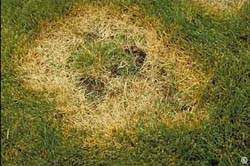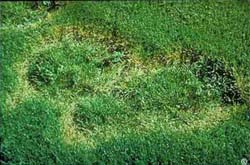Necrotic ring spot disease is one of many that can affect lawns. This disease is difficult to control and the most common lawn problem in Colorado. The disease causes rings of dead grass, about one foot in diameter, in a lawn. It’s caused by a fungus, but no mushrooms are associated with the ring.
 The best control is preventative practices, such as rototilling soil and adding organic material before sodding. The fungus responsible for necrotic ring spot lives in the soil. Adding organic material to the soil helps grass maintain a healthy root system, helping it ward off disease on its own.
The best control is preventative practices, such as rototilling soil and adding organic material before sodding. The fungus responsible for necrotic ring spot lives in the soil. Adding organic material to the soil helps grass maintain a healthy root system, helping it ward off disease on its own.
Necrotic ring spot disease can be managed by core aerating the lawn at least once a year to slowly improve soil conditions and root growth. Avoid over fertilizing and frequent, light watering. It is better to water the grass infrequently and deeply, forcing the grass roots to develop to a depth of six to eight inches. Mowing heights should be maintained at approximately two and one-half to three inches.

Since the disease is so difficult to manage, alternative grass choices should be considered. Perennial ryegrass is not susceptible to this disease and is commonly used to overseed affected areas. There are also some Kentucky bluegrass varieties such as Midnight and Eclipse that are resistant.
For more information, see the following Colorado State University Extension fact sheet(s).



